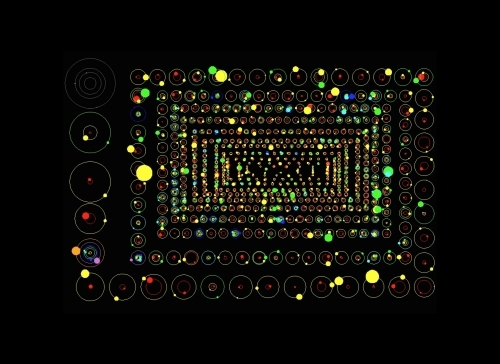Paul Gilster's Blog, page 167
October 14, 2015
KIC 8462852: Cometary Origin of an Unusual Light Curve?
Dysonian SETI operates under the assumption that our search for extraterrestrial civilizations should not stop with radio waves and laser communications. A sufficiently advanced civilization might be visible to us without ever intending to establish a dialogue, observed through its activities around its parent star or within its galaxy. Find an anomalous object difficult to explain through conventional causes and you have a candidate for much closer examination.
Is KIC 8462852 such a star? Writing for The Atlantic, Ross Andersen took a look at the possibilities yesterday (see The Most Mysterious Star in Our Galaxy), noting that this F3-class star puts out a light curve indicating not a planetary transit or two, but a disk of debris. That wouldn’t be cause for particular interest, as we’ve found numerous debris disks around young stars, but by at least one standard KIC 8462852 doesn’t appear to be young. In a paper on this work, Tabetha Boyajian, a Yale University postdoc, and colleagues see it as a main sequence star with no kinematic indication that it belongs to the population of young disk stars.
The age of a star can be a hard thing to calculate, and unfortunately, at 1480 light years, this one is too far away for us to measure its rotation period or gauge its chromospheric activity. [Addendum: My mistake: Jason Wright just pointed out that we do have data on rotation period and chromospheric activity — the problem is that these are not good age indicators for F-class stars].
But the authors also find that there is no excess emission at mid-infrared wavelengths of the kind we would expect from a dusty disk. That makes for an object unusual enough to have caught the eye of a Dysonian SETI specialist like Jason Wright (Penn State), who told Andersen “Aliens should always be the very last hypothesis you consider, but this looked like something you would expect an alien civilization to build.” Working on a paper of his own, Wright and his co-authors find the star’s light pattern not inconsistent with a swarm of large structures.
One of the classic Dysonian SETI scenarios would be the discovery of a Dyson sphere, an artificial construction built around the parent star to harvest the maximum energy possible. Such a sphere, although frequently depicted in fiction as a solid object, would more likely exist as a swarm of orbiting objects, and as we imagine these things, a light signature like KIC 8462852’s could be the result. That makes the search for alternative explanations all the more interesting, as we try to understand what natural causes might explain the KIC 8462852 light curve.

Image: This view of Comet Halley’s nucleus was obtained by the Halley Multicolour Camera (HMC) on board the Giotto spacecraft, as it passed within 600 km of the comet nucleus on 13 March 1986. The recent paper on KIC 8462852 discusses a cometary influx as a possible cause of the unusual light curves. Credit: ESO.
We’re fortunate to have four full years of Kepler data on this target, allowing the authors to explore a range of possibilities. A large-scale impact within the system is the first thing that comes to my mind. On that score, think of something on the scale of the event that caused our own Moon to form. The problem here is the time frame. The collision would have had to occur between observations from the WISE observatory and a large dip in flux (nearly 15%) seen in later Kepler observations, because we would expect such an event to trigger a strong infrared excess that was not seen by WISE. Such an excess could be there now, but this would also mean that we chanced upon an impact that occurred within a window of just a few years.
Coincidences happen, so we can’t rule that out. The paper also considers catastrophic collisions in this star’s analogue to our asteroid belt, as well as the possibility that we are seeing the passage of a disintegrating comet through the system. In this scenario, the comet would have passed well within one AU. Add in a few other factors and it might work:
The temperatures of comets at such close proximity to the star (> 410 K) would render them susceptible to thermal stresses. The existence of multiple super-Earth planets orbiting < 1 AU from many main sequence stars also points to the possibility that the comet could have been tidally disrupted in a close encounter with one such planet. It is even possible that the comet came close enough to the star for tidal disruption in the absence of other considerations; e.g., a comet similar to Halley’s comet would fall apart by tidal forces on approach to within 3–7 stellar radii (0.02 – 0.05 AU).
And this:
Also, since fragments of the comet family would all have very similar orbits, this mitigates the problem noted in Section 4.4.2 that the detection of multiple transits may require orders of magnitude more clumps to be present in the system. Instead a single orbit is the progenitor of the observed clumps, and that orbit happens to be preferentially aligned for its transit detection. That is, it is not excluded that we have observed all the clumps present in the system.
But can the comet scenario explain details in the light curves of KIC 8462852? The paper notes how much remains to be explored, but concludes that a cometary explanation is the most consistent with the data. Conceivably a field star might have made its way through this system, triggering instabilities in KIC 8462852’s analogue to the Oort Cloud. There is in fact a small nearby star that whether bound to the system or not could be implicated in cometary infall.
So what’s next? Andersen tells us that Boyajian is now working with Jason Wright and Andrew Siemion (UC-Berkeley) on a proposal to study KIC 8462852 at radio frequencies that could implicate the workings of a technological civilization. That could lead to further work at the Very Large Array in New Mexico. All of this is as it should be: The appropriate response to a stellar anomaly is to study it more closely while working through a range of possibilities that might explain it. The fact that we don’t see a light curve like this among any of Kepler’s other 156,000 stars is telling. Whatever is going on here is rare enough to merit serious follow-up.
The paper is Boyajian et al., “Planet Hunters X. KIC 8462852 – Where’s the flux?” submitted to Monthly Notices of the Royal Astronomical Society (preprint).






October 13, 2015
A Mission to Jupiter’s Trojans
Back in 2011, a four planet system called Kepler-223 made a bit of a splash. Researchers led by Jack Lissauer (NASA Ames) at first believed they were looking at two planets that shared the same orbit around their star, each circling the primary in 9.8 days. These co-orbital planets were believed to be in resonance with the other two planets in the system. If the finding were confirmed, it would indicate that one planet had found a stable orbit in a Lagrange point — the L4 and L5 Lagrange points lie 60° ahead and behind an orbiting body. We call an object sharing an orbit like this a trojan, as shown in the figure below, which depicts the best known trojans in our system, the asteroids associated with Jupiter.
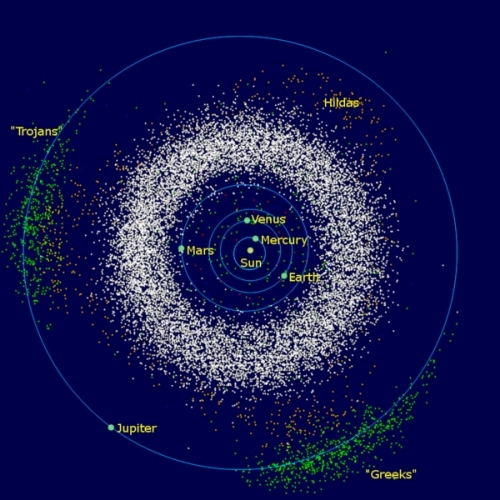
Image: Jupiter’s extensive trojan asteroids, divided into ‘Trojans’ and ‘Greeks’ in a nod to Homer, but all trojans nonetheless. Credit: “InnerSolarSystem-en” by Mdf at English Wikipedia – Transferred from en.wikipedia to Commons. Licensed under Public Domain via Commons.
By sheer coincidence I have been reading Peter Green’s splendid new translation of The Iliad (University of California, 2015), so I pause for a moment on the classical theme in naming conventions for Jupiter’s trojans. The German astronomer Max Wolf was the first to spot one of Jupiter’s trojans in 1906, naming it 588 Achilles. Their number quickly swelled, and we now have over 6000 identified Jovian trojans, with a total population of objects over one kilometer in diameter believed to be about one million. The trojan 617 Patroclus, another Homeric reference, was found in 2006 to be composed of water ice, making the Jupiter trojans interesting sources of volatiles.
The work on Kepler-223 was the first time we thought we had found something as large as a trojan planet, but Lissauer and team soon realized that a different interpretation of the light curve was more likely, one in which one of the two co-orbital possibilities had an orbital period that was twice the original estimate. Too bad, because this was quite a fascinating find. There has been speculation that the Earth itself may have once had a small planet at one of its Lagrange points, the ‘Theia’ impactor whose collision with our planet would have produced the Moon.
We now know that trojans can appear at many places in our Solar System, with seven under study at Mars, nine at Neptune, and 2010 TK7 confirmed as the first known Earth trojan in 2011. But Jupiter’s population remains the most robust, and given the composition of 617 Patroclus, it’s good to see that a mission design to explore the Jupiter trojans is emerging. One of five investigations recently chosen by NASA for further study, the project, called Lucy, comes out of the Southwest Research Institute, with Harold Levison as principal investigator.
“This is a once-in-a-lifetime opportunity,” Levison said of the proposed 11-year mission. “Because the Trojan asteroids are remnants of that primordial material, they hold vital clues to deciphering the history of the solar system. These asteroids are in an area that really is the last population of objects in the solar system to be visited.”
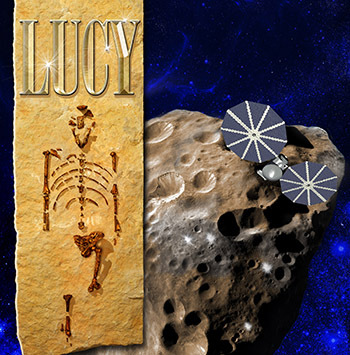
$3 million will go into the concept design studies and analysis involved in developing a mission that would study five of the Jupiter trojans, with a launch some time in 2021. The final trojan encounter would occur in 2032. This SwRI news release discusses a spacecraft package containing remote-sensing instruments to study the physical properties of trojans, with three imaging and mapping instruments including a color imaging and infrared mapping spectrometer, a high-resolution visible imager, and a thermal infrared spectrometer. The name ‘Lucy’ is a reference to the fossil remains of an early hominid dating back over three million years.
Image: Lucy, an SwRI mission proposal to study primitive asteroids orbiting near Jupiter, is one of five science investigations under the NASA Discovery Program up for possible funding. Credit: SwRI.
From the standpoint of naming conventions, we haven’t quite finished with the Jovian trojans, though. It turns out that before the idea of naming these objects after Homeric references had fully stabilized, with ‘Trojans’ on one side (L5 in relation to Jupiter) and ‘Greeks’ on the other (L4), both 617 Patroclus and the even more martial 624 Hektor were assigned positions in the wrong camps. Not a recipe for tranquility for any classicist — it was Hector who finished off Patroclus, an event that led to the return of Achilles to battle and a sea-change in the fortunes of the war around Troy.






October 12, 2015
Pluto’s Circumbinary Moons
Kepler-47 is an eclipsing binary some 4900 light years from Earth in the direction of the constellation Cygnus. It’s a system containing two transiting circumbinary planets, meaning the planets orbit around the binary pair rather than around one or the other star. That configuration caught the eye of Simon Porter, a postdoc at the Southwest Research Institute, because the configuration is so similar to another circumbinary system, the one involving four small moons around Pluto/Charon. In both cases, we have a binary at the center of the orbit. Porter writes about the configuration in this post from the New Horizons team.
In the case of Pluto, the binary could be considered a binary planet, with Charon the other half of the duo. Both are orbited by a system of four moons, each of them less than 50 kilometers in diameter, the moons orbiting around the system’s center of mass. New Horizons, the gift that keeps on giving, has already sent some striking images of these small moons, but we have even better imagery yet to come as we continue to download data from the craft’s Long Range Reconnaissance Imager (LORRI), the high resolution camera that has given us so so many unforgettable images already. But I’ll open the week with an image not from LORRI but from the Multispectral Visible Imaging Camera, just to provide a sense of context and a bit of awe.
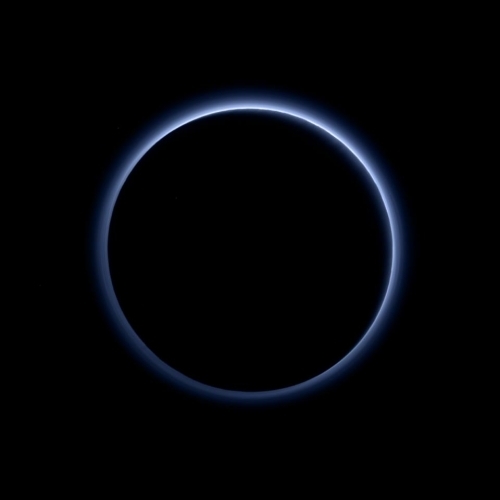
Image: Pluto’s haze layer shows its blue color in this picture taken by the New Horizons Ralph/Multispectral Visible Imaging Camera (MVIC). The high-altitude haze is thought to be similar in nature to that seen at Saturn’s moon Titan. The source of both hazes likely involves sunlight-initiated chemical reactions of nitrogen and methane, leading to relatively small, soot-like particles (called tholins) that grow as they settle toward the surface. This image was generated by software that combines information from blue, red and near-infrared images to replicate the color a human eye would perceive as closely as possible. Credit: NASA/JHUAPL/SwRI.
Blue atmospheric haze in the Kuiper Belt is not something anyone was expecting. SwRI’s Carly Howett offers a read on what we’re seeing:
“That striking blue tint tells us about the size and composition of the haze particles. A blue sky often results from scattering of sunlight by very small particles. On Earth, those particles are very tiny nitrogen molecules. On Pluto they appear to be larger — but still relatively small — soot-like particles we call tholins.”
This JHU/APL news release has more, explaining current thinking that tholins form in the upper atmosphere as ultraviolet light breaks nitrogen and methane molecules apart, allowing them to form increasingly complex negatively and positively charged ions that recombine to form macromolecules. Small particles can grow out of the process, with volatile gases condensing to coat their surfaces before they fall back to the surface, adding to its reddish hue.
But back to the system of moons. The closest to New Horizons during the July encounter was Nix, of which LORRI has delivered three close-ups so far. Have a look at the object as, in the second view, it reveals its ‘potato-like’ aspect — the elongation is lost in the first image because we’re looking down the long axis. What stands out here is the size of that crater. Are we looking at a fragment of an older moon, as Porter speculates, or was Nix just lucky to have survived a shot that could leave a crater of that size on such a small surface? A crescent Nix shows up on the far right, which may yield information on the surface of the diminutive moon.
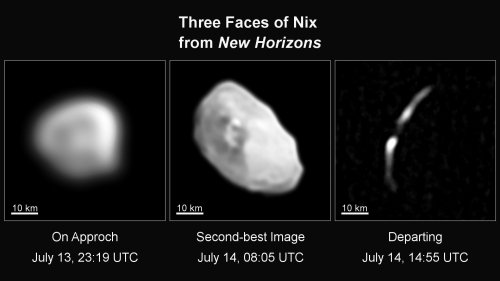
Image: Pluto’s moon Nix is viewed at three different times during the New Horizons July 2015 flyby. Credit: NASA/JHUAPL/SwRI.
Now have a look at Nix as seen through the Ralph/Multispectral Visible Imaging Camera. Here we’re working with only a quarter of LORRI’s resolution, but we’ve got color now and can discern that most of Nix is white, while that provocative crater and the ejecta it produced show up as reddish. It’s a natural assumption that Nix’s interior is made up of much darker material than the surface. “We don’t actually know what either the dark or the light material is,” writes Porter, “nor will we be able to tell until we download the Nix data from the Ralph-Linear Etalon Imaging Spectral Array (LEISA) composition mapping spectrometer.”
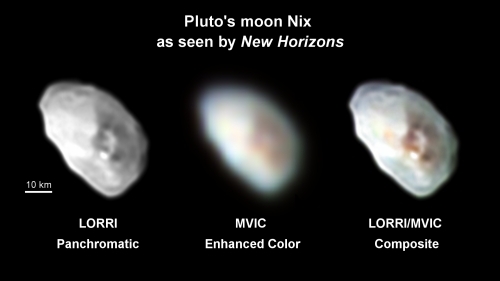
Image: Pluto’s moon Nix is shown in high-resolution black-and-white and lower resolution color. Credit: NASA/JHUAPL/SwRI.
Below is Hydra as seen through LORRI, with the caveat that this moon was on the other side of Pluto during close approach, so we don’t have the same level of resolution we had for Nix. Porter notes a certain similarity in aspect with another object that caught our attention this summer: Comet 67P/Churyumov-Gerasimenko, around which the ESA’s Rosetta spacecraft continues its operations. In both cases, we have the possibility of a low-speed collision which melded two originally separate objects. The images of Styx and Kerberos that we’ll get later in the year, by the way, should be of roughly the same resolution as this image of Hydra.
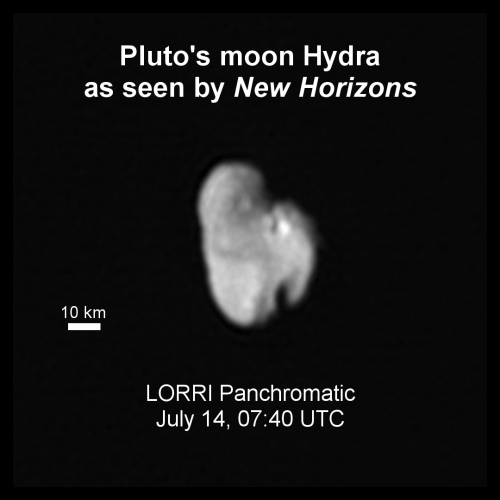
Image: Pluto’s moon Hydra as seen from NASA’s New Horizons spacecraft, July 14, 2015. Credit: NASA/JHUAPL/SwRI
New Horizons also detected surface water ice on Pluto, with areas showing the most apparent water ice signatures corresponding to areas that appear red in other recent images of Pluto. Figuring out how water ice interacts with the reddish tholins is going to take some work.
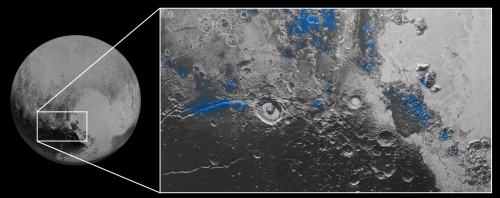
Image: Regions with exposed water ice are highlighted in blue in this composite image from New Horizons’ Ralph instrument, combining visible imagery from the Multispectral Visible Imaging Camera (MVIC) with infrared spectroscopy from the Linear Etalon Imaging Spectral Array (LEISA). The strongest signatures of water ice occur along Virgil Fossa, just west of Elliot crater on the left side of the inset image, and also in Viking Terra near the top of the frame. A major outcrop also occurs in Baré Montes towards the right of the image, along with numerous much smaller outcrops, mostly associated with impact craters and valleys between mountains. The scene is approximately 450 kilometers across. Note that all surface feature names are informal. Credit: NASA/JHUAPL/SwRI.
In addition to the sheer thrill of seeing places as tiny as Nix at some level of detail, not to mention the often startling and mesmerizing views of Pluto and Charon themselves, I note the fact that exoplanets have become so common that we can draw analogies from our catalogues to describe what we see in our own system, as Simon Porter did in his description of Pluto’s moons. The world has changed so much in the past twenty years of exoplanet hunting, meaning that our view of ourselves and our place in the universe has been much enriched, and we have a panoply of planetary configurations to draw on as we consider how solar systems are made.






October 9, 2015
SETI: A Networked Galaxy?
We often conceive of SETI scenarios in which Earth scientists pick up a beacon-like signal from another star, obviously intended to arouse our attention and provide information. But numerous other possibilities exist. Might we, for example, pick up signs of another civilization’s activities, perhaps through intercepting electromagnetic traffic, or their equivalent of planetary radars? Even more interesting, as Brian McConnell speculates below, is the idea of listening in on a galactic network that contains information not just from one civilization but many. As Centauri Dreams readers know, McConnell and Alex Tolley have been developing the ‘spacecoach’ concept of interplanetary travel, discussed in the just published A Design for a Reusable Water-Based Spacecraft Known as the Spacecoach (Springer, 2015). It’s a shrewd and workable way to get us deep into the Solar System. Today McConnell turns his attention to a SETI network whose detection could offer a big payoff for a young civilization.
by Brian McConnell

With the revival of SETI funding, it’s interesting to contemplate what we might find if SETI succeeds. One possibility that is especially tantalizing is that first contact would not be with an individual civilization but rather a large scale network of civilizations that is organized not unlike the Internet. This is not a new idea (Timothy Ferris and others have explored this concept) but it is one that should be considered seriously. Assuming that communicative civilizations are commonplace, a big if of course, a decentralized or mesh network will be the most time and energy efficient way for them to organize their communications.
Consider the energy cost of sending a unit of information from one edge of the galaxy to the other (~ 100,000 light years) via direct means versus a peer-to-peer relay system. The savings ratio can be estimated as:
daverage / wgalaxy
If communicative civilizations are separated by an average distance of, say, 1000 light years, the energy cost of sending a unit of information across the galaxy via relay will be about 1/100th that of direct communication. The energy requirement per link drops off by the ratio of (daverage / wgalaxy)2 but as more hops are required with shorter links, the overall energy requirement drops by daverage / wgalaxy. This is an approximation, but it highlights the order of magnitude improvements in economy, and suggests that if communicative civilizations are widespread, energy economics and other considerations will favor this type of arrangement.
Reliability and redundancy are another important feature of a mesh network. When sending information across such great distances, and with such long transit times, a sender may want to protect especially important information against loss or corruption by sending it repeatedly or by sending it via multiple paths between endpoints. This technique can virtually guarantee that information is eventually transmitted even if the network is damaged, even without the use of sophisticated forward error correction codes. This isn’t to say that an extraterrestrial intelligence will copy the TCP/IP protocol, but it’s safe to assume that someone who is sophisticated enough to build an interstellar communication link will probably be familiar with the characteristics and benefits of decentralized mesh networks.
There will also be benefits to receivers, especially newcomers, as contact with one node will be the same as contacting many nodes, since any node in the network can function as a relay for others. The cost of joining the network is also reduced, as a new node need only establish communication with its nearest neighbors, and can relay messages to and receive information from any other site on the network. Such a network would not merely be a communication system, but also a long term repository of knowledge as important information from long dead civilizations could continue to circulate throughout the network in perpetuity.

Image: The Milky Way as seen from the mountains of West Virginia. Could the galaxy be filled with the traffic of networked civilizations? Credit: ForestWander.
Fermi Implications
The existence of such a system might also help explain the Fermi Paradox, as the most energy efficient mode of operation, in terms of detecting new civilizations, will be for each node to concentrate its detection efforts on its immediate neighborhood using a listen and reply strategy. There would be little point in building powerful omnidirectional beacons that are detectable over great distances, as they would cost far more energy to operate, would have to wait millennia for a response, and would be plagued by duty cycle issues. Better for peripheral nodes to listen for microwave leakage from nearby civilizations as they develop early communication technology, and then target those for active communication soon after they are detected. This sort of strategy would be cheap both in terms of energy and the number of radio-telescopes required at each node in the network, and would offer a high probability of success in detecting new nodes just as they become active, while not wasting energy by transmitting in the blind.
An important point to consider here is that an emerging technological civilization would become detectable independently of any intent to attempt interstellar communication. Indeed here on Earth, the vast vast majority of energy expended on electromagnetic signaling has been for purposes other than Active SETI. It seems likely that most technological civilizations would go through a period where they are microwave bright, even if they later go dark due to transitioning to other technology, fear of ETI contact, etc.
As we would just now be detectable to nodes within about 100LY (80LY is probably a better estimate), we would just now expect to be receiving a response from a node within 40-50LY. It’s possible that rapid changes in atmospheric spectra, as Earth has experienced with the sudden increase in carbon dioxide, might also serve as a early tripwire for attempting active communication, but those could be ambiguous signals with natural explanations like volcanism, whereas a sudden spike in monochromatic microwave transmission points definitively to a technological origin. Viewed from the network’s perspective, this decentralized strategy would enable detection of new sites with the least energy expenditure and the shortest possible lag time between detection and active communication, with the added bonus feature that the first nodes to establish contact could relay stored information from nodes far beyond the initial radius of communication. On the other hand, if the average distance between nodes is large, it may be a long time before the nearest nodes are aware of us, and it may be hard for such a network to become established in the first place.
Choice of Encoding Schemes
Another interesting aspect of a long running galactic communication system is that there will be a natural selection of sorts that favors the message encoding schemes that are most likely to be mimicked. The selection pressure in this case will favor an encoding scheme that is broadly comprehensible (easy to understand the basic design pattern) and flexible (able to accommodate many different types of information via that framework). A transmission that is extremely difficult to parse, for example because of strong encryption or sophisticated forward error correction codes, is less likely to be mimicked than one whose basic design pattern is comprehensible to many receivers, even if it is less than optimal in terms of capacity or error resistance. This leads to the fittest message being more likely to replicate (be mimicked in retransmission) than its competitors. This is also an incentive for civilizations wishing to project influence through remote communication to design messages that peer sites will want to and be able to copy.
The point is not to speculate about what would be in such a message, but how it is organized at a low level. To build a mesh network that can handle many data types, you don’t need a very sophisticated message format, even if some of the data types sent within the message are extremely complex or difficult to comprehend. Typically you break a large amount of data, be it a file or communication stream, into smaller predictably organized subunits which are labeled with metadata, which might include:
a frame or packet number : identifies a message segment’s position within a collection, file, stream, etc
a collection or file number : to identify a larger grouping of frames, pages, packets, etc
an author or sender number : to identify the author or sender of a particular segment.
a receiver number : to identify the intended recipient, if any
a content identifier : to identify the type of content represented by the frame or packet
a blob of data, or payload, that is described by the above metadata
While one could design more complex schemes, the above defines the minimal set of metadata needed to describe something like a mesh network or file system with many files, authors and varying file types. What someone decides to convey with such a system is a different matter entirely, but a mesh network in its simplest form consists of a long chain of | meta data | blob of data | meta data | blob of data | segments with obvious repeating structures.
Implications for SETI
While the basic design pattern of a system like this can be rather simple, it will be capable of delivering data that varies widely in content type and “difficulty level”, and also offers a high degree of durability (important message fragments can be resent out of sequence or sent via multiple paths). Some content types such as rasterized or bitmapped images will probably be nearly universally understood due to their utility in astronomy and space photography, while others that are based on advanced math may be unrecognizable to many recipients. It’s not unlike DNA, whose basic encoding scheme has just four letters, yet can encode for something as simple as an isolated protein or as complex as a human being. That’s one of the interesting characteristics of the fittest message — it should be easy to parse at a low level, yet capable of conveying data types representing a wide range of complexity.
All of this suggests that SETI surveys should be concentrating a portion of their observing time on nearby targets. This also suggests that a large scale network will probably need to find us before we can find it, but will also be relatively easy to spot once it does. This doesn’t exclude other possibilities, and indeed SETI should be trying many strategies in parallel, from looking for distant beacons to Bracewell probes.
Should we encounter a network like this, the implications of that would be nothing short of staggering because of the volume and variety of information that could flow through a system like this. It’s possible that much of that communication will be over our heads. On the other hand, the quasi Darwinian selection pressure on message formats may favor those that are broadly comprehensible, or at least contain elements like rasterized photos that virtually any astronomically communicative receiver can understand, including us.






October 8, 2015
A Comparative Look at Solar Systems
With almost 2000 exoplanets now confirmed, not to mention candidates in the thousands, it’s amazing to recall that it was just twenty years ago that the first planet orbiting a main sequence star beyond the Solar System was found. Continued work on the world revealed that 51 Pegasi b is about half as massive as Jupiter, though 50 percent larger. Orbiting its star in roughly four days, the planet is some fifty light years from Earth. Thus we began to learn not just that exoplanets were out there, but that their environments could be truly extreme — remember that it was just in 1992 that planets were found around the pulsar PSR 1257+12.
Without any evidence other than my imagination, I grew up believing that most stars should have planets, and just assumed that their stellar systems were more or less like our own. There should be a few planets too close to their star for life to exist, and several gas giants out at the outskirts of the system, and somewhere in between there should be a world not so different from Earth. It was a naive view, but not completely implausible, and anyway, we lacked data.
Discovering ‘hot Jupiters’ is one way we began to realize that other configurations could exist, and the number of ‘super-Earths’ has made the same case. Just how ‘normal’ is our Solar System in the first place? A new paper from Rebecca Martin (University of Nevada, Las Vegas) and Mario Livio (Space Telescope Science Institute) tackles the question, comparing what we see in our Solar System to our growing database of exoplanetary information.
Obviously, this is a work in progress, for we’re not only still examining abundant Kepler and K2 data but continuing a robust planet hunt that looks forward to space-based missions like TESS (Transiting Exoplanet Survey Satellite) and PLATO (PLAnetary Transits and Oscillations of stars), surveys of considerable scope that should build our catalog of ‘nearby’ planets. Nonetheless, we can draw some conclusions based on what we see in the image below.
Image (click to enlarge): Model of all the multi-planet systems found by Kepler as of November 2013; our terrestrial planets are shown in grey at the top left for comparison. A new study examines how our solar system compares to the exoplanetary systems we’ve found. Credit: NASA/Kepler/Dan Fabricky.
Our Solar System is composed of a good deal more than planets, of course, which leads to an important caveat, one that Martin and Livio mention early on in the paper. We have two belts orbiting the Sun, the main asteroid belt and the Kuiper Belt. The problem is that although we can see a number of debris and dust belts around other stars, belts with as little mass as ours would not be observable to us around other stars. So a study like this one has to base its findings solely on planets. It can be mentioned, though, that hundreds of debris disk candidates are now in play, and about two-thirds of these are best modeled as two component disks.
That’s a plus for the idea that our Solar System isn’t all that atypical. What about the planets? The authors use a mathematical transformation that allows them to set up a statistical comparison. The low mean eccentricity of planets around our Sun is one area where we differ from other multi-planet systems — our planets move in largely circular orbits — but as the paper notes, our observation methods are biased toward finding high eccentricity planets. Circular orbits work to our benefit, for planets with low eccentricity are more likely to be dynamically stable. Indeed, the terrestrial planets in our system are thought to be stable until that distant time when the Sun becomes a red giant and disrupts the entire inner system.
What about age? The Sun is about half the age of the Milky Way disk, hardly setting up our system as special, and at least one study has found that about 80 percent of existing Earth-like planets were already formed when the Earth came into existence. We also know that terrestrial planets in the habitable zone of their host star appear to be common. The paper notes, for example, the work of Courtney Dressing and David Charbonneau, which uses Kepler data for M-dwarfs and finds an occurrence rate for Earth-sized planets in the habitable zone of 18% to 27%, a conservative estimate that Martin and Livio say could be as high as 50 percent (see How Common Are Potential Habitable Worlds in Our Galaxy?)
If we’re not unusual in terms of age or habitability, we do differ considerably from other systems in two respects. First, we have no planets inside the orbit of Mercury, in contrast to systems with rocky worlds on far closer orbits. Moreover, the Solar System lacks a super-Earth, a category of planet now turning out to be common.
The paper summarizes its findings this way:
We find that the properties of the planets in our solar system are not so significantly special compared to those in exosolar systems to make the solar system extremely rare. The masses and densities are typical, although the lack of a super-Earth-sized planet appears to be somewhat unusual. The orbital locations of our planets seem to be somewhat special but this is most likely due to selection effects and the difficulty in finding planets with a small mass or large orbital period. The mean semi-major axis of observed exoplanets is smaller than the distance of Mercury to the Sun. The relative depletion in mass of the solar system’s terrestrial region may be important. The eccentricities are relatively low compared to observed exoplanets, although the observations are biased toward finding high eccentricity planets. The low eccentricity, however, may be expected for multi-planet systems. Thus, the two characteristics of the solar system that we find to be most special are the lack of super-Earths with orbital periods of days to months and the general lack of planets inside of the orbital radius of Mercury.
So while we’ve had quite a few surprises in the past twenty-five years, going from no exoplanets known to planets around pulsars and then main sequence stars, and moving from those early detections to thousands of candidates, we’re not seeing anything that would peg us as being unique. In terms of habitability, the authors see nothing in the Solar System that would make it especially conducive to life’s formation as opposed to other planetary systems:
If exosolar life happens to be rare it would probably not be because of simple basic physical parameters, but because of more subtle processes that are related to the emergence and evolution of life. Since at the moment we do not know what those might be, we can allow ourselves to be optimistic about the prospects of detecting exosolar life.
That lack of a super-Earth troubles me, though. Systems that have a super-Earth generally have more than one. The authors ask a good question: Does the presence of a super-Earth affect terrestrial planet formation? Several studies have looked at a migrating super-Earth moving slowly through the habitable zone, finding that a terrestrial planet that forms there later will tend to be rich in volatiles. Many observed super-Earths are found in orbits where they were unlikely to have formed, so scenarios of super-Earth migration surely deserve further study.
The paper is Martin and Livio, “The Solar System as an Exoplanetary System,” The Astrophysical Journal Vol. 810, No. 2 (3 September 2015). Full text.






October 7, 2015
AU Mic: Intriguing Features in a Protoplanetary Disk
The European Southern Observatory’s SPHERE instrument is turning up interesting things around the star AU Microscopii. Surrounded by a large dusty disk, the star is young enough to raise the interest of those studying how planets form. What has turned up are structures that Anthony Boccaletti (Observatoire de Paris) describes as ‘arch-like, or wave-like,’ a structure that his research team has never seen before. The issue is addressed in a new paper in Nature, which discusses five wave-like arches at different distances from the star.
Fortunately, AU Mic is a well studied star, with abundant Hubble imagery taken in 2010 and 2011 available for comparison. The results of that comparison are striking: The features do indeed show up on the Hubble imagery, but they show distinct change with time, meaning they are in rapid motion. “We reprocessed images from the Hubble data and ended up with enough information to track the movement of these strange features over a four-year period,” explains team member Christian Thalmann (ETH Zürich, Switzerland). “By doing this, we found that the arches are racing away from the star at speeds of up to about 40 000 kilometres/hour!”
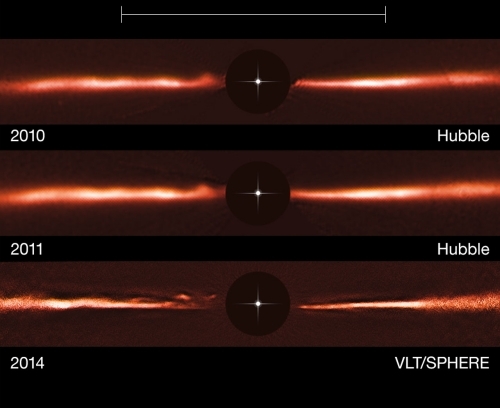
Image: Using images from ESO’s Very Large Telescope and the NASA/ESA Hubble Space Telescope, astronomers have discovered never-before-seen structures within a dusty disc surrounding a nearby star. The fast-moving wave-like features in the disc of the star AU Microscopii are unlike anything ever observed, or even predicted, before now. The origin and nature of these features present a new mystery for astronomers to explore. The results are published in the journal Nature on 8 October 2015. Credit: ESO.
Disturbances in a protoplanetary disk are always intriguing — think of the star Beta Pictoris, another object whose disk is well studied, with observations showing disk anomalies that flagged the presence of at least one fledgling planet. But what’s happening at AU Mic is challenging to understand. The arch-like features furthest from the star appear to be moving faster than those closer in, with at least three of them moving fast enough to escape AU Mic entirely. The team believes that they could not be caused by planets disturbing disk material as they orbit, nor do spiral waves triggered by disk instabilities offer an explanation.
Complicating the observations is the fact that we see AU Mic’s disk edge-on, making an examination of its three-dimensional structure all the more difficult. Is stellar activity the answer? Perhaps, says co-author Glenn Schneider (Steward Observatory, University of Arizona):
“One explanation for the strange structure links them to the star’s flares. AU Mic is a star with high flaring activity — it often lets off huge and sudden bursts of energy from on or near its surface. One of these flares could perhaps have triggered something on one of the planets — if there are planets — like a violent stripping of material which could now be propagating through the disc, propelled by the flare’s force.”
But the range of possibilities is large. From the paper:
Another case of interest may involve the presence of a planetary magnetosphere. Planetary magnetic field lines reconnect with the magnetized stellar wind creating a magnetotail which can lead to cyclical ejections of plasma out of the tail. Dust particles interacting with the ejected plasma are accelerated by the Lorentz force which is dominant over gravity. This would yield an outflow pointed away from the star, and may explain the super-Keplerian velocities of a few tens of km/s and possibly vertical transport with respect to the disk midplane. Such magnetotail ejections are observed in the solar system from Jupiter and Saturn 1–2 au away from the planet.
Just 32 light years from Earth, AU Mic is obviously going to receive a great deal of further observation, with the Boccaletti team planning to extend its work to the Atacama Large Millimeter/submillimeter Array (ALMA), located in the Atacama desert of northern Chile. SPHERE, meanwhile, is quickly proving itself in its first year of observation. An acronym for Spectro-Polarimetric High-contrast Exoplanet REsearch instrument, SPHERE takes as its domain the realm of direct exoplanet imaging, which of course includes debris disks.
To make these observations, the instrument, which is mounted on Unit Telescope 3 of the Very Large Telescope at ESO’s Paranal Observatory, uses a coronagraph to block out the bright central star as it examines planets or disks. The system also uses differential imaging, which plays off the fact that starlight is unpolarized, while starlight reflected off the surface of a planet or a dusty disk is partially polarized. SPHERE is designed to pick out the polarized signal, isolating it from the stream of unpolarized light by using special filters. Throw in adaptive optics to correct for turbulence in the Earth’s atmosphere and you get an instrument that can provide a sharp view of objects close to the central star, such as the now mysterious disk around AU Mic.
The paper is Boccaletti et al., “Fast-Moving Structures in the Debris Disk Around AU Microscopii,” Nature 8 October 2015.






October 6, 2015
Habitability Index Ranks Exoplanets
If we had a space-based instrument fully capable of analyzing an exoplanet’s atmosphere in place right now, where would we find our best targets? The goal, of course, is to pluck out the signature of biological activity, which means we’re looking at planets in the habitable zone of their stars, that region where liquid water can exist on the surface. Right now there aren’t many planets that fit the bill, but the day is coming when there will be hundreds, then thousands. How we optimize our search time and choose the targets with the most likely pay-off is a major issue.
Which is where a new metric called the ‘habitability index for transiting planets’ comes into play. Developed by Rory Barnes and Victoria Meadows (University of Washington), working with research assistant Nicole Evans, the index is an attempt to prioritize the selection process, looking at those exoplanets that should be at the top of our list. Says Barnes:
“Basically, we’ve devised a way to take all the observational data that are available and develop a prioritization scheme, so that as we move into a time when there are hundreds of targets available, we might be able to say, ‘OK, that’s the one we want to start with.’”
Kepler has already given us a taste of what’s ahead, with its datasets rich in planets, but when we launch TESS (Transiting Exoplanet Survey Satellite) and later PLATO (PLAnetary Transits and Oscillations of stars), we’ll be looking at a much broader field. Bear in mind that Kepler took its ‘long stare’ out along the Orion Arm, where 156,000 stars were in range to be analyzed for the lightcurves that identify planetary transits. That’s a way of using brute force methods to get a statistical reading on how common various kinds of planets are in the galaxy.
But most of the stars in the Kepler field of view are hundreds if not thousands of light years away — fewer than one percent of them are closer than 600 light years. So the starfield in Cygnus and Lyra that gave us such sensational results with Kepler will now be supplanted with the search for planets closer to home, and a TESS field of view that will cover 400 times as much sky. TESS should be a good target-finder for the James Webb Space Telescope, whose launch in 2018 will open up the possibility of studying the atmospheres of such worlds.
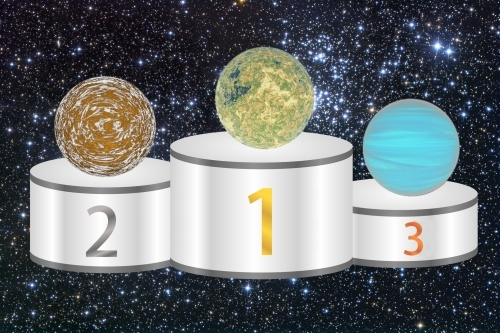
Image: UW astronomers Rory Barnes and Victoria Meadows of the Virtual Planetary Laboratory have created the “habitability index for transiting planets” to compare and rank exoplanets based on their likelihood of being habitable. Credit: Rory Barnes.
Barnes and Meadows presented their habitability index in a paper for The Astrophysical Journal called ‘Comparative Habitability of Transiting Exoplanets.’ The goal is to move well beyond what has thus far been the ‘first cut’ for habitable planets, the question of whether they can have liquid water on the surface. The index takes particular account of the planet’s ‘eccentricity-albedo degeneracy,’ which examines the energy reflected off its surface (albedo) and weighs it against the circularity of its orbit.
This gets into an interesting balancing act. High albedo means a great deal of light and energy being reflected back into space, so that less is available at the surface. And eccentric orbits can create intense periods of energy influx, during which the planet passes closest to its star. As the paper notes, there is an equilibrium that marks the most life-friendly zone given these factors. In the excerpt below, H refers to the habitability index number:
Our approach to comparative habitability assessments parameterizes the eccentricity-albedo degeneracy by calculating the fraction of all possible (A, e) [albedo, eccentricity] pairs that could produce a clement climate. We must also assess “rockiness” probabilistically based on inferences from the few planets with well-known masses and radii. Despite these assumptions, H can provide more insight into a planet’s potential to support life than simply comparing its orbit to that of its host star’s HZ.
Applying the index to the Kepler dataset produces some interesting results:
We ranked the known Kepler and K2 planets for habitability and found that several have larger values of H than Earth. This does not mean these planets are “more habitable” than Earth – it means that an Earth twin orbiting a solar twin that is observed by Kepler would not have the highest probability of being habitable. The best candidates have incident radiation levels, assuming circular orbits, of 60–90% that of Earth’s. These levels are about in the middle of the HZ, which is not surprising as our flux limits are derived from the models that produced the HZ. Our method is grounded in the fundamental observables and can, when applicable, fold in eccentricity constraints, and is therefore more powerful than the HZ for transiting exoplanets.
The age of the star can also be a useful data point when it comes to habitability. Here we look at the timescale on which life arises, a challenging issue because all we have to work with is what we know of life’s development on Earth. In general, the paper notes, planets in the habitable zone of F, G or K stars should see the last wave of giant impacts on their young surfaces at around 100 million years. Given that impacts likely sterilized our planet for several million years, this is an important issue, and stellar age, if known, can factor into the question of habitability.
A habitability index like this one isn’t designed for a single mission, but anticipates creating a target list we’ll want to investigate with a variety of technologies. The James Webb Space Telescope will be the first spacecraft that can perform transit transmission spectroscopy, but the paper notes that planets with high values of H could well be unobservable by JWST because of its detection capabilities. Barnes and Meadows examined four candidates for JWST spectroscopy — these were all Kepler or K2 detections — and found that even detecting water bands on these would be challenging for JWST. What TESS may identify as the best target for JWST won’t necessarily be the best target for later missions with different instrumentation.
The paper is Barnes, Meadows & Evans, “Comparative Habitability of Transiting Exoplanets,” accepted at The Astrophysical Journal (preprint). A UW press release is also available.






October 5, 2015
Unusual Orbits for Unusual Missions
Our choice of orbits can create scientifically useful space missions that can be operated at lower cost than their more conventional counterparts. How this has been done and the kind of missions it could enable in the future is the subject of James Jason Wentworth’s essay. An amateur astronomer and interstellar travel enthusiast, Wentworth worked at the Miami Space Transit Planetarium and volunteered at the Weintraub Observatory atop the adjacent Miami Museum of Science. Now making his home in Fairbanks (AK), he was the historian for the Poker Flat Research Range sounding rocket launch facility. His space history and advocacy articles have appeared in Quest: The History of Spaceflight magazine and Space News.
by J. Jason Wentworth
In the 1990s, then NASA Administrator Daniel S. Goldin introduced the “Better, Faster, Cheaper” paradigm for space missions. While NASA’s subsequent experiences led many engineers to modify that to “Better, Faster, Cheaper–choose two,” the goal of low cost has remained a primary goal for space mission planners. One way to reduce the cost of a mission is to select a trajectory that requires the least possible change of velocity (called Delta-V by engineers and orbital dynamicists) to achieve the mission’s objectives. This requires less propellant aboard the spacecraft, which results in a smaller and lighter spacecraft, which in turn can usually be lofted by a smaller and less expensive launch vehicle. (Very high-energy missions such as New Horizons are exceptions. In such cases, launching the smallest possible spacecraft merely makes such missions possible within a practical flight duration–even when using the most powerful launch vehicles available–because the velocities required for even the lowest-energy trajectories are so high.)
Another factor that affects the spacecraft’s required amount of onboard propellant is the stability of the mission orbit. If frequent orbital adjustments are necessary for any reason, a larger propellant reserve will be required, which will bump up the probe’s size and mass. The type of spacecraft stabilization system that is used also has an influence on the propellant reserve. A three-axis stabilized probe in orbit around the Moon, the Sun, another planet, or any other body will require more thruster firings (to point its sensors and imaging system at its target body, and to aim its high-gain antenna at Earth) than will a spin-stabilized spacecraft, so the latter can operate for many years using very little propellant for attitude control.
The spin-stabilized Pioneer spacecraft all exhibited this characteristic of very long life. Perhaps the most impressive of the series (besides the Sun-orbiting Pioneer 6 – 9 interplanetary probes, which lasted for multiple decades; two of them may still be functioning) was the Pioneer Venus Orbiter, which returned images of and data on the planet (and Comet Halley) for nearly 14 years, in the hostile thermal and solar radiation environment around Venus. [1] In March of 1986 Pioneer 7 also flew within 12.3 million kilometers (7.6 million miles) of Halley’s Comet and monitored the interaction between the cometary hydrogen tail and the solar wind. It discovered He+ plasma produced by charge exchange of solar wind He++ with neutral cometary material. [2]
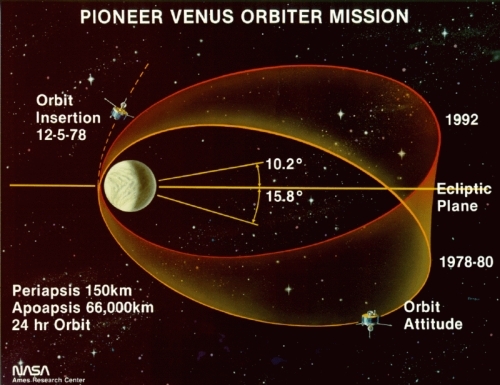
Image: Orbit attitude of Pioneer Venus 1 between 1978 – 1980 and 1992. Credit: NASA/Ames.
Since the space age began, other trajectories besides the classical Hohmann transfer ellipse have been devised to get satellites and space probes to their destination orbits or worlds. These are used to minimize the necessary Delta-V, or to optimize planet arrival times, or both. Some geosynchronous satellites are now first injected into “super-synchronous” transfer orbits from their initial low-altitude parking orbits, from which they are later maneuvered downward into their 24-hour operational orbits. The Pioneer Venus Orbiter traveled along a similar path to Venus; it was boosted from its parking orbit around the Earth into a solar orbit that initially passed outside the Earth’s orbit about the Sun before curving inward to intercept Venus in its orbit.
Other unusual types of orbits exist, some of which were discovered when asteroids were found to be moving in them, and they are also useful for low-Delta-V (and thus lower cost) space missions. The best-known ones are halo orbits and the tadpole-shaped Lissajous orbits, in which several spacecraft have traveled around the Sun-Earth L1 and L2 Lagrangian points and the Earth-Moon L1 and L2 points.
Enter the Horseshoe Orbit
A more recently-discovered path (which a 2011 Centauri Dreams article, Stable Orbit for a Newly Discovered Companion, discusses) is the horseshoe orbit, which got its name from its shape. [3] A small object in such an orbit goes around the Sun in a normal, low-eccentricity (close to circular) elliptical orbit in the direct (prograde) direction, but since its orbit has nearly the same period and shape as the orbit of a nearby planet (Earth, in the case of the horseshoe-orbiting asteroids discovered to date), gravitational interactions with Earth create the horseshoe path (which occurs only in the Earth-centered reference frame, as the asteroid orbits around the Sun normally). This celestial “dance” works as follows:
As the asteroid is about to pass the Earth in its slightly lower, more rapid orbit, the Earth’s gravity pulls it toward itself; this speeds up the asteroid, which causes it to move farther from the Sun (and thus into a higher orbit), and this then causes the asteroid to slow down, because objects in higher orbits move more slowly. In its higher, slower orbit, the asteroid then begins to drop behind the Earth, slowly “drifting” backwards all the way around the Sun (from the Earth’s perspective–the asteroid is orbiting the Sun in the same direct [prograde] direction as Earth, just more slowly). Many years later, as the asteroid again approaches Earth (from ahead of our planet this time), the Earth’s gravity slows down the asteroid, which causes it to fall into a lower, faster orbit around the Sun. Now moving faster than the Earth (inside Earth’s orbit), the asteroid slowly “drifts” all the way around the Sun again (moving forward this time, from Earth’s perspective), after which it repeats the whole horseshoe orbit cycle again. [4]
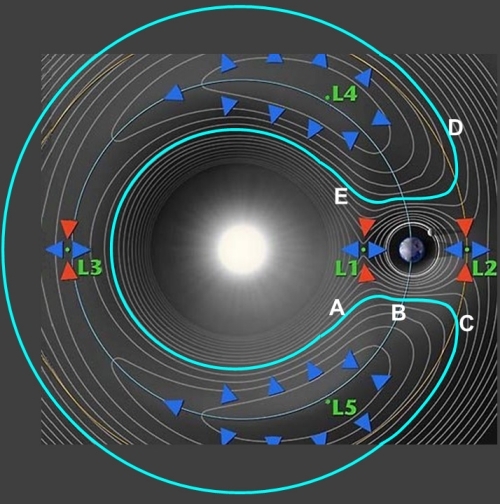
Image: A horseshoe orbit, showing possible orbits along gravitational contours. In this image, the Earth (and the whole image with it) is rotating counterclockwise around the Sun. Credit: Wikimedia Commons.
While other asteroids in horseshoe orbits with respect to Earth have been found before, their orbits aren’t long-term stable. Within a certain range of distances, orbital eccentricities, and velocities, however, stable horseshoe orbits are possible, and the asteroid 2010 SO16 (the subject of the Centauri Dreams article in Reference 3) is in one, having possibly followed its current orbit for up to two million years. In addition, it is possible–as 2010 SO16 might have done, as is mentioned in the article–for asteroids (or other objects, such as spacecraft) to librate (migrate) from Lissajous orbits around the Sun-Earth L4 or L5 Lagrangian points into stable horseshoe orbits. Migration from a horseshoe orbit back into a Lissajous orbit might also be possible, and what an unpowered asteroid could do, a self-powered space probe could likely also do–using little propellant.
Another unusual kind of orbit is the quasi-satellite orbit, in which NEAs (Near-Earth Asteroids) have also been discovered. [5] A quasi-satellite is in an orbit around the Sun that has a 1:1 resonance with the orbit of a particular planet. This causes the quasi-satellite to stay close to that planet over many orbital periods. A quasi-satellite’s orbit has the same period as the planet’s orbit, but the quasi-satellite’s orbit has a different–usually greater–eccentricity than the planet’s orbit. As observed from the planet, the quasi-satellite appears to move in an oblong retrograde loop around the planet, although both bodies are orbiting the Sun in direct (prograde) orbits.
Orbital Dynamics and ‘Fuzzy Boundaries’
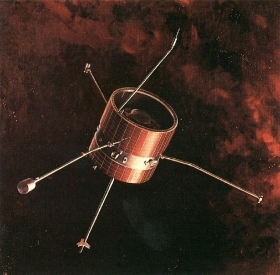
Pioneer E (which would have been named Pioneer 10 if it had not been lost in its failed launch on August 27, 1969) was the fifth and last of the series of solar-powered, drum-shaped Sun-monitoring interplanetary probes that began with Pioneer 6 in December of 1965, and Pioneer E was intended to orbit the Sun as a quasi-satellite of Earth. Had it reached its planned solar orbit, Pioneer E (which was launched–and lost–with the TETR C test and training satellite, the intended third “practice” satellite for the Apollo tracking and communications network) would have passed inside and outside the Earth’s orbit, alternately speeding up and slowing down relative to Earth. This would have kept Pioneer E within 16 million kilometers (10 million miles) of Earth during the spacecraft’s design lifetime of from six months to two and one-half years. [6] (It would likely have operated for much longer than two and one-half years, as its sister probes Pioneer 6 – 9 demonstrated.)
Image: Artist’s conception of the Pioneer 6–9 spacecraft. Credit: NASA.
Orbit changes could be done using even less propellant (virtually none, in some cases) by employing Dr. Edward Belbruno’s principle of gravitational “Fuzzy Boundaries,” which involve the physics of chaos. [7, 8, and 9] This was first demonstrated in 1991 after Japan’s first lunar probe, the combined Hiten/Hagoromo spacecraft, ran into difficulties. Launched on January 24, 1990, the craft was injected into a highly-eccentric elliptical Earth orbit that passed beyond the Moon. The tiny Hagoromo lunar orbiter separated from Hiten during its first lunar swing-by and fired its solid propellant retro-rocket as the vehicles passed the Moon; while Hagoromo entered lunar orbit as intended, its radio transmitter failed when its retro-rocket fired (optical telescopic observation from Earth confirmed its entry into lunar orbit), which rendered it scientifically useless. [10] On March 19, 1991, Hiten performed the first-ever aerobraking maneuver, skimming the Earth’s atmosphere to change its orbit.
Having learned of Hagoromo’s transmitter failure, Edward Belbruno approached ISAS (the Institute of Space and Aeronautical Science) and offered to help them get their still-functioning Hiten lunar flyby spacecraft into lunar orbit. The probe, which was in a highly-eccentric Earth orbit, was moving much too fast during its lunar flybys to brake into lunar orbit using its onboard propellant. But by utilizing his “Fuzzy Boundaries” method, which involved using the combined gravity of the Moon and the Earth, on October 2, 1991 Hiten’s flight controllers were able to maneuver the probe into a preliminary, temporary lunar orbit using almost no propellant. After that, Hiten was targeted to fly through the Earth-Moon L4 and L5 points to collect data on any meteoric dust that was thought to possibly have accumulated there (none was detected). On February 15, 1993, Hiten was directed into a permanent lunar orbit, where it remained until it was deliberately crashed on the lunar surface on April 10. [11]
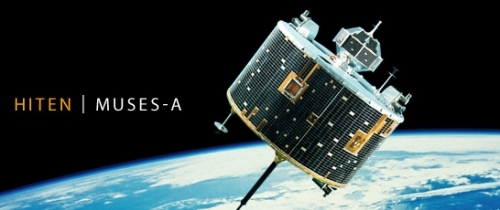
Image: An artist’s conception of the Hiten spacecraft. Credit: JAXA.
A Panoply of Applications
Stable horseshoe solar orbits and quasi-satellite solar orbits–entered and/or exited with the aid of Dr. Belbruno’s “Fuzzy Boundaries” method, making use of planetary as well as solar gravity–would be useful for Pioneer 6 – E type solar monitoring probes, which could observe portions of the Sun that cannot be seen (at any given time) from Earth. They could also, in concert with solar observations from Earth (or from Earth satellites), make stereo observations of solar features at many places along their horseshoe or quasi-satellite orbits. These same solar probes could also, as the Sun-orbiting Pioneer 7 interplanetary probe did, encounter and examine comets that pass through or near their orbits (flybys of asteroids that pass them would also be possible). If necessary, such probes could modify their horseshoe or quasi-satellite orbits (speeding up or slowing down, as needed) in order to make closer flybys of comets and asteroids (and later return to their original orbits) using very little propellant. Or, the probes could utilize solar sail propulsion (a simplified heliogyro sail should work nicely) to make such orbit changes, using no propellant at all.
Another application for horseshoe and quasi-satellite solar orbits would be to place NEO (Near-Earth Object) space telescopes in such orbits, much closer to the Sun than Earth’s distance. These locations would enable the spacecraft to see Earth-crossing NEOs whose orbits keep them mostly inside Earth’s orbit, and objects that could become dangerous to Earth in the future (via gravitational encounters with Venus and/or Mercury) would also be visible to these spacecraft. (To telescopes on or near the Earth, the sunlit sides of these small, often dark-colored objects face away from our planet, making them virtually impossible to see in the Sun’s glare, and Earth-based telescopes could never search for them in a truly dark sky because they would never be far from the Sun.) The B612 Foundation and its aerospace industry partner Ball Aerospace plan to send their NEO-seeking Sentinel space telescope to a Venus-like solar orbit for this reason. [12 and 13]. A horseshoe orbit or a quasi-satellite orbit “threaded around” Venus’ orbit about the Sun could reduce the necessary Delta-V (and thus the spacecraft’s launch vehicle and onboard propellant requirements) by utilizing Venus’ gravity to help establish–and later maintain by itself–either type of orbit for the Sentinel spacecraft.

Image: The Sentinel Space Telescope, being built by the B612 Foundation. Credit: B612Julie (Own work) [CC BY-SA 4.0 (http://creativecommons.org/licenses/by-sa/4.0)], via Wikimedia Commons.
Closer to home, Earth-centered horseshoe orbits–in which evenly-spaced communication, weather, or Earth resources satellites could “cycle” around the Earth as if on a circular conveyor belt (with two sets of spacecraft, on the inner and outer edges of the “belt”)–could provide global coverage not only of Earth, but they could also serve as communication relays for the lunar farside and for the Earth-Moon L2 point behind the Moon. (For circum-terrestrial horseshoe orbits, the Moon’s gravity would serve the same function that the Earth’s gravity does for Sun-centered horseshoe orbits that are “threaded around” Earth’s orbit about the Sun.) They could also provide close-up lunar observation to monitor time-variant lunar phenomena (the lunar “dustosphere’s” monthly cycling under the influence of Earth’s magnetotail, lunar meteorite impacts during meteor showers, TLP [the luminous Transient Lunar Phenomena], etc.).
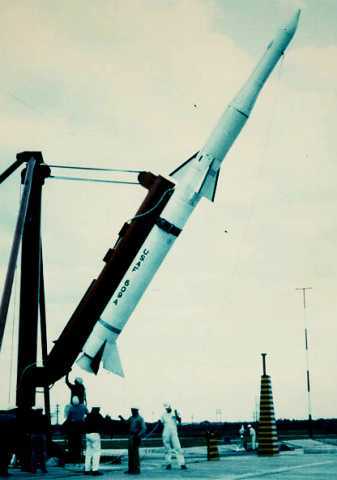
Surprisingly, even low-cost suborbital interplanetary missions are possible. In addition to gathering data on the time-variant phenomena of the interplanetary environment, they could also collect dust, ice, and gas samples from comets that pass relatively close to Earth. NASA’s simple, inexpensive solid propellant Scout satellite launch vehicle, manufactured by LTV (Ling-Temco-Vought) using existing “off-the-shelf” rocket motors, was also used for several high-altitude suborbital probe missions that reached tens of thousands of kilometers into space. [14] (A rocket that ascends to an altitude of one Earth radius or higher is considered a space probe rather than a sounding rocket, because reaching one Earth radius requires a rocket velocity that is equal to Low Earth Orbit [LEO] orbital velocity.) The U.S. Air Force’s Blue Scout vehicles (which were similar to the NASA Scout vehicles for the most part, but were somewhat different because they were produced by a different contractor, the Ford Motor Company’s Aeronutronic Division) also flew numerous probe missions. [15 and 16] One in particular, a Blue Scout Junior launched from Cape Canaveral on August 17, 1961, reached an altitude of 225,000 kilometers (140,000 miles)–more than halfway to the Moon–on a suborbital flight lasting days. Unfortunately, the payload’s transmitter failed during the final (fourth) stage’s burn, rendering the flight scientifically useless. [17 and 18]
Image: The Blue Scout Junior. Credit: Peter Alway/Encyclopedia Astronautica: http://www.astronautix.com/index.html.
In his 1957 book The Making of a Moon: The Story of the Earth Satellite Program (and in its 1958 post-Sputnik revised second edition), Arthur C. Clarke pointed out that by launching suborbital vehicles at velocities approaching Earth’s escape velocity, their payloads could reach altitudes of millions of miles before falling back to Earth. [19] Interestingly, the altitudes achieved begin to increase dramatically at only 35,000 kilometers per hour (22,000 miles per hour), significantly below Earth’s escape velocity. As he wrote: “A rocket launched vertically at 22,000 miles an hour–or four thousand miles an hour faster than a satellite–would reach an altitude of about fifteen thousand miles before gravity checked its speed and it fell back to Earth. Slight further increases in velocity would give altitudes of millions of miles, until at the critical speed of 25,000 miles an hour the rocket never came back at all.”
Such vehicles could be very small–the 7.3-meter (24-foot) long, balloon-launched Project Farside probe rockets of the late 1950s, which reached nearly orbital velocity and rose to altitudes of between 3,200 and 5,000 kilometers (2,000 and 3,100 miles) with 1.4 to 3.3 kilogram (3 to 5 pound) payloads, could have reached the vicinity of the Moon with the addition of a fifth stage, which was proposed. [20] But this proposal was not proceeded with, possibly because the electronics technology of those days likely wouldn’t have enabled such small payloads to return meaningful data from the Moon’s distance (the frequent failures of the Farside vehicles’ payload transmitters also didn’t encourage much confidence in more ambitious ventures). But today a full suite of instruments, an S-band or X-band telemetry transmitter, and their solar cell or battery power supply could be accommodated in payloads of that mass range.
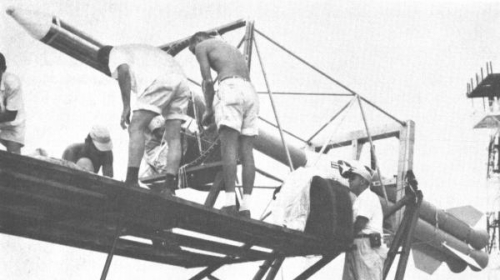
Image: Working on Project Farside. Credit: Parsch, Directory of U.S. Military Rockets and Missiles: http://www.designation-systems.net/dusrm/app4/farside.html.
Existing high-performance multi-stage sounding rockets could, if topped with multiple high-velocity stages, boost heavier payloads to such velocities (similar vehicles have boosted artificial meteors to velocities far in excess of escape velocity, beginning in 1957). [21 and 22] Such “souped-up” sounding rockets, or small–particularly air-launched satellite launch vehicles with additional upper stages, such as Orbital Sciences Corporation’s Pegasus XL and the upcoming Boeing ALASA (Airborne Launch Assist Space Access) system–could loft small suborbital interplanetary probes. [23 and 24] This capability would make possible low-cost, rapid comet sample return missions to “targets of opportunity,” comets such as IRAS-Araki-Alcock and Hyakutake that pass within a few million kilometers of Earth.
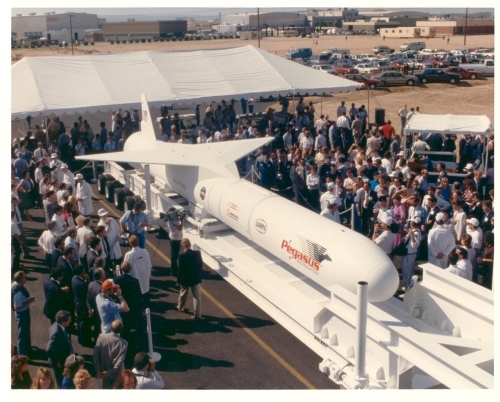
Image: The Pegasus XL launch vehicle operated by Orbital Sciences Corporation. Credit: NASA.
The recoverable portion of the spacecraft could use a deployable aerogel particle collector that would be housed in a small, blunt re-entry heat shield similar to that of the Pioneer Venus Small Probes or the Japanese Hayabusa and Hayabusa 2 asteroid sample return probes. The expendable section of the spacecraft, which would burn up upon re-entry into the Earth’s atmosphere, would carry fields and particles instruments and an imaging system. At other times, such suborbital probes could collect intact meteoroids from meteor shower streams for return to Earth, and/or they could gather data on the far regions of Earth’s magnetosphere and magnetotail, including their interactions with the solar wind and the solar magnetic field. Since the parent bodies of many meteor shower streams are now known (most originate from comets–a few are from asteroids), suborbital probes would offer inexpensive, frequent, and regular opportunities for collecting samples of these objects.
By substituting subtlety and cleverness for brute force, and by letting some mission targets come to their probes more than vice-versa, many new, scientifically useful, and inexpensive space missions would become practical and affordable. In addition to garnering new knowledge, such missions would also provide more frequent opportunities for young scientists, engineers, and orbital dynamicists to gain hands-on experience in designing and executing deep space missions–experience that would be of great help to them when the time comes to tackle the more ambitious outer solar system and observatory missions that NASA hopes to fly in the coming decades.
——-
References
1. Pioneer Venus Project Information, National Space Science Data Center website: http://nssdc.gsfc.nasa.gov/planetary/pioneer_venus.html
2. Pioneer 6, 7, 8, and 9, Wikipedia article: https://en.wikipedia.org/wiki/Pioneer_6,_7,_8,_and_9
3. Stable Orbit for a Newly Discovered Companion, Centauri Dreams article: http://www.centauri-dreams.org/?p=17484
4. Horseshoe orbit, Wikipedia article: https://en.wikipedia.org/wiki/Horseshoe_orbit
5. Quasi-satellite, Wikipedia article: https://en.wikipedia.org/wiki/Quasi-satellite
6. TRW Space Log, Winter 1969-70, Vol. 9, No. 4, Pioneer E, TETR C entry on pages 40 – 43.
The National Space Science Data Center http://nssdc.gsfc.nasa.gov/ has a Pioneer E mission page at http://nssdc.gsfc.nasa.gov/nmc/spacecraftDisplay.do?id=PIONE.
7. Edward Belbruno, Wikipedia article: https://en.wikipedia.org/wiki/Edward_Belbruno
8. Edward Belbruno : Mathematics, Astrophysics, Aerospace Engineering (Edward Belbruno’s Official Website): www.edbelbruno.com
9. SpaceRoutes.com website: http://www.spaceroutes.com/intro.html
10. Hiten (Muses-A) JAXA webpage: http://www.isas.jaxa.jp/e/enterp/missions/hiten.shtml
11. Hiten, Wikipedia article: https://en.wikipedia.org/wiki/Hiten
12. Sentinel Space Telescope, Wikipedia article: https://en.wikipedia.org/wiki/Sentinel_Space_Telescope
13. Sentinel Mission website (mission overview page): http://sentinelmission.org/sentinel-mission/overview/
14. LTV (Vought) SLV-1 Scout, Designation Systems article: http://www.designation-systems.net/dusrm/app3/lv-1.html
15. Ford RM-89 Blue Scout I, Designation Systems article: http://www.designation-systems.net/dusrm/app1/rm-89.html
16. Ford RM-90 Blue Scout II, Designation Systems article: http://www.designation-systems.net/dusrm/app1/rm-90.html
17. Ford RM-91 Blue Scout Junior, Designation Systems article: http://www.designation-systems.net/dusrm/app1/rm-91.html
18. Blue Scout Jr, Encyclopedia Astronautica article (with launch chronology): http://www.astronautix.com/lvs/bluoutjr.htm
19. The Making of a Moon: The Story of the Earth Satellite Program by Arthur C. Clarke, pages 149 – 150 (First Edition, Published 1957 by Harper & Brothers Publishers, New York, NY, Library of Congress catalog card number: 57-8187 [a post-Sputnik revised edition, the same book with that update, was published in 1958])
20. Aeronutronics Farside, Designation Systems article: http://www.designation-systems.net/dusrm/app4/farside.html
21. Possible Challenge to Sputnik on Unmanned Spaceflight website: http://www.unmannedspaceflight.com/lofiversion/index.php/t1955.html
22. The First Shots Into Interplanetary Space by Professor Fritz Zwicky, California Institute of Technology Library website: http://calteches.library.caltech.edu/181/1/zwicky.pdf
23. Boeing to Design DARPA Airborne Satellite Launch Vehicle, Boeing.com website: http://www.boeing.com/features/2014/03/bds-darpa-contract-03-27-14.page
24. DARPA’s ALASA space launch system from airplane, wordlessTech.com website: http://wordlesstech.com/darpas-alasa-space-launch-system-from-airplane/






October 2, 2015
Woven Light: The Orphan Obscura
Heath Rezabek began exploring Vessel, an evolving strategy for preserving Earth’s cultures and biology, in these pages back in 2013. A librarian and writer in Austin TX, Heath went on to push these ideas into the realm of science fiction, in the form of a series of excerpts from a longer work that is still emerging. The concluding post in this sequence appears below, though you’ll be hearing more about ‘Woven Light.’ A novel is emerging from this haunting look at how, at various points in our future and with a wide range of technologies, we will interact with the artifacts and stored experience of our past. Heath’s helpful synopsis begins the post.
by Heath Rezabek

For some time, I have had in hand the final chapter – for now – of the Woven Light speculative fiction series as published on Centauri Dreams from 2013 to present. At Paul’s invitation, I am prefacing the final installment with some notes on the series as a whole.
The series began as a way to explore ideas surrounding the prospects for human or posthuman space travel, and the role which might be played by very long term archives in the resilience of life’s efforts to endure. I am not finished with the themes explored in the series, but for now it is time to shelve this particular approach to the storyline, along with its characters.
After feedback last year at the Turkey City Writer’s Workshop in Austin Texas, and encouragement from a few other parties, I am pursuing a new approach to the story arc, from an entirely different time and place in its imaginary history. The goal is to produce a cohesive and more linear novel, exploring world(s) we’ve only glimpsed so far; the Centauri Dreams installments of Woven Light are a (somewhat fragmented and dreamlike) hint at what is to come.
Here follow episode summaries of each of the published episodes, with links to their versions here.
Vessel Haven (I). We are introduced to an entity called Tracer Aakanthia [9T33], who is exploring a holographic archival site. We meet Aben Ramer, encountering a mock-up of a Vessel Haven – a very long term archive – at the Burning Man festival, circa 2023.
Adamantine (II). We meet Mentor Kaasura, who is exploring a ruinous region, the site of an ancient disaster. He rests at a pilgrimage shelter. We learn about an artificial life project meant to provide a guiding sentience for a starship. The sentience is named Avatamsaka; the starship – a lightsail – is named Saudade. We also learn about two offshoots of humanity: the Avaai and the Ghemaai.
Augmented Dreamstate (III). We meet Aben’s mother, Thea, an author of speculative fiction, as she struggles with a draft of her work. We meet Dr. Jota Kaasura, who bears an unknown relation to Mentor Kaasura from the prior installment. Dr. Kaasura is working on a project called Augmented Dreamstate, which allows the immersive visualization, exploration, and recording of scenarios. He explores one such: the scene on the day of a disaster.
Proteaa (IV). We explore a spaceborne habitat derived from an idea of Freeman Dyson, which he’d referred to as an Ark Egg. Here they are called Precursorae, and within them dwell beings called Proteaa. Vannevar Bush’s Memex is considered, along with an exercise developed by Thea Ramer for coaxing concepts out of a flux of random ideas: Wildcards. Dr. Kaasura meets someone unexpected, and dreams of drifting habitats far from the Precursorae.
Lesson Arcs (V). Thea Ramer publishes her novel, The Tracer Guild, but life has other plans. Years later, Aben Ramer meets Dr. Kaasura, and lays the groundwork for him to meet with Thea. In another time and place, perhaps aboard our lightsails, we meet Vaarea Ramer, one of the Ghemaai, immersed in worldbuilding lessons that are passed from mind to mind.
Age of Release (VI). Mentor Kaasura explores deep passages woven of light, beyond the shelter’s door. Far flung from there, a fog of mind called Ancient Light sifts the space between stars, finding worlds where planetbound life had nearly reached the Age of Release. Aben Ramer determines researches in one of his favorite spots for thinking, and makes a new friend.
For those who would like a plain manuscript version, in sequential order, this PDF can be found here. It includes a short Appendix of previously unreleased developmental fragments from the drafting table].
I look forward to sharing future excerpts from the new effort with Centauri Dreams as well, should Paul welcome it.
Here, at last, is the final installment (for now!) of Woven Light: A special series for Centauri Dreams, 2013-2015.
Woven Light: The Orphan Obscura (VII)
Across town, mother wasn’t doing so well.
Sorting had led to spreads, as Thea rediscovered cards she’d scribbled on years ago, and laid them out the way she remembered, five across to find three akin. She’d pull them aside, and then would remember. How it had felt: To write with an explorer’s eyes, cresting a hill to shine the light of awareness on inevitable mountains.
Eyes closed, still she could see Ityl-Atys spread below her. Wings outspread, a raptor keen and bright of eye . . . She could see the bazaar, the outlying districts, the towers of abandon. Red streaks in distant sun spread golden rivulets, a quilt of sands for all below them.

Image 1: Based on photograph CC BY Michal Huniewicz.
And below, she remembered, delved Vaachez, his dusted hat long since traded in fair exchange for a rough and partial map; his map now guidance through at least one dimension of battered space.
Thea read an untold chapter to herself. So easily, but traceless. No recorder. This time, no traces. She only wanted to know.
~ I only want to know. ~
Vaachez made his way along the higher moraine, beams and slabs settled well for this stratum, clearstone lending its glow to light his way.
His pack was both lighter and more burdensome now, its baubles and bits traded for rarified things needed further down, when stealth failed him. So far, trading had sufficed. But trading had grown more scarce since the post where Oaami, his guide, had bowed, and remained behind. “All I have left to offer, I have whispered to this map,” she had said; and handing it to him, she had turned to her ascent.
From there, he had endured the broken way with only scrapes and the parching isolation of stealth to test him.
In time, even the need for stealth had faded, as the last small settlements carven into these caverns had scattered, and subsided altogether. But the weight he carried now was of most use down here; his ascent would depend on encountering someone else descending, the only ones for whom such things would hold the value they held for him now.
He’d had no word of other tracers when he’d ducked into the shade of the lower bazaar. He couldn’t depend on them. So far as he knew, he was the only pathfinder still drawn to this old mystery.
He had to know. Ascent or an ending, he only wanted to know.
Vaachez worked his way slowly around the edge of a drop, a good ten stories, rusty cable scraping the leather of his gloves, smell of dust and sunbeams still (thank the moon) refined by his breather.
Around the bend; only a little further, if this map was anything at all.
Across the way, just then, he glimpsed it: a bird of some sort, winged its way across the chamber above this blockage. Setting sunlight from a shaft far above them caught its wingtips: a dash of burnished wings. A piercing cry. Alight and keen, now, on the opposite ledge.
A clambering clatter in the softlight, ancient ledgers falling still. Vaachez stood, staring straight at the watcher and pierced right through in return. He couldn’t make out the size of the bird, but its shape was nearly regal. So sharp and feral, whittled by chance and opportunity.
It shifted one leg; he did the same. Nothing gave. Exhaling, Vaachez turned to see the rumored landing not a dozen streetwidths on. From there, by map, the ruins descended in wide slabs and steps, far enough that by the time he reached the fabled site, dusk would have fallen far above. Already the air was quickly cooling.
Inhaling again: ~ All things struggle ~. Exhaling again: ~ On each other we depend. ~ Vaachez switched his grip upon the cable, and stepped ahead.
From its perch, the great raptor could see the dustling balance and edge onwards, surefooted and determined.
Hours later, now sharpened in the cool air from his slow descent of switchbacks, he rested. Vaachez stood again on solid slabwork, trying to adjust his eyes to blue shadows. On beams and slabs around him, he thought at one point he had glimpsed vegetation. How possible was that, so far down below? He climbed the final rise, a silent beachhead, and stood before . . .
At first he saw a mountain. Before his mind could calm his heart he felt it sink at the thought of another climb. But no: this was an illusion. Peak there was, quite clearly rising, all in dusky blue and — yes — clad in clambering green. Darkling down below, it rose and reared at the peak as a beam full of moonlight was filtered down to impossible pools at the base of the beamwork.
And beamwork it was: a steeple of sorts, tentpoled and rising, rooted in its subterranean oasis, foundations wide at the base. There, perhaps, it sat: the Orphan, Obscura. How could he know?
Seeing himself at a ledge, an impassable drop to the oasis below, he stopped, and sat, and stared.
By now his eyes had adjusted quite well to the indigo dark, and he could see and sense that the ruin was extensive, though not as massive as some above ground. But sheltered in this space, this domed duskland, it seemed as if a miniature of something vast. Truth enough was that he couldn’t tell. It couldn’t be as large as it seemed. The space was so quiet, the air so still, the sound of water trickling so clear in the silence it carved.
Inhaling again; exhaling again.
Behind him, a cry: and a winged shadow passed not so far above his shoulder, on his right. Friend from the ledge-crossing, it needed a name. And as it made its way across the gap to perch on rising angles, he decided its name was Zinn.
The distance was greater than he’d thought; the edifice was huge. It slumber was deep. Its voice . . .
He sat before the Orphan. He would speak with it, or nothing.

Image 2: Based on photograph CC BY-SA Al Jazeera
Letting his focus go soft, he steadied his gaze and his breathing, until before him in the settled shape of the ruins he could see a seated figure, Grandfather Silence, casting long shadows. And as his gaze drifted, it fell like the dust, and settled on wellsprings deep at the base . . . And tilted his gaze as he found there a gap of a threshold. Uncertain, he still saw what seemed like — another. Seated at the entry, a tiny mountain settled down beneath the mountainous shadow. Who would break the stillness? Who would answer?
He broke the stillness. ~ I sit before you, a traveller and a friend. I have heard only whispers, but even rumors have a cause. ~
Only dust in deep night air, so slowly.
~ I am called Vaachez. I am an orphan like you. ~
And as Zinn watched, the figure sat with silence.
And the silence stretched on, and on.
~ He has come a long way, ~ croaked Zinn. ~ He has come to know your tale. ~
The Orphan Obscura stirred then, and murmured; ~ He knows it already. ~
Zinn shook and settled, a flutter and a silence like an avian shrug. ~ He may have forgotten. ~
~ Then he is not the one to discover it anew. ~
Zinn cocked one eye, and sized the dustling up and down. ~ He may be the last. Their house is fading. ~
~ He may be the first. Their house is a seedling. ~ The Orphan Obscura shifted something, from one place inside its expanse to another.
~ If he leaves without knowing, he leaves without purpose. ~
Obscura muttered. ~ If he leaves without knowing, he leaves too soon. ~
Perturbed by this back and forth, Zinn took wing, sailing up into the rafters, and swinging down towards the base, where Vaachez’ watery eyes were still fixed. And landing there, she found a pile.
~ What is this heap? ~ She picked at the leaves.
~ It sits and waits. ~ Obscura surveyed a shallow pool at its feet, located a treasure.
~ No time to wait! ~ A fluttering dance. ~ The sun is near! The moon is full! The sleepy stir and soon they’ll wake; for what, a pile? A heap of memories? ~ Zinn darted down to peck at something shiny.
~ A heap of time, slow and intact. That is no small thing. ~ Obscura turned a stone slowly in its gaze, and beneath the stars its etchings caught the ancient light. ~ I have done what I can. ~
Zinn circled the stack of remnants there, wondering if Vaachez could read at such a distance.
She decided he could, and took wing.
~ You’ve done what you can; and so have I. ~
Vaachez sat, parched and quite lonely. The bird had flown suddenly, surely, up and beyond the loose strata far above him. He was alone with his vigil.
Before him slumped a place where forgotten things slept, and waited for a stronger will than his to wake them. But Zinn had been right about one thing: his eyes were keen. And he could read, in that cairn of debris far below, a secret hint of kindness.
Vaachez mulled his reckonings.
All about him, far above him, intolerable weight bent, balanced over its remnants. The Orphan Obscura was not alone, and several more of its kind lay at rest, he knew, slumbering guardians at the roots of other citistates. But if they were all as drowsy as Obscura, there was no way the long work of the Tracer-Guild, and the pathfinders before them, and the dreamhunters before that, could ever come to fruition.
~ Sojourner, peace. You are not alone; nor am I. ~
Vaachez opened his eyes, not realizing they’d been closed, to see the color changed in this space from dusk to slow dawning. He leaned in, peering closely at the form at ruin’s threshold, before the climbing light in this chamber swamped his eyes. Already it was growing violet.
~ A thousand ruins does not a remembrance make. ~ Vaachez furrowed, scolded the fading night.
~ A thousand and one. It takes only one, unruined and found, to spark a rekindling.
~ Obscura raised its gaze, and still could see the moon. Something on its surface glinted, and it too was unalone.
Vaachez rose. Of course the citistate Orphans weren’t the only Orphans out there. Just the most encumbered.
He would find another. He would find a site intact. Would he have to leave the Tracer-Guild, or would they understand?
He looked down at the water, hoping it wasn’t a trick of the mind. He’d need to fill his skins before he made his ascent. Shifting his glance to his rope, he surveyed the situation. He had to get down there, and he had to get back up.
Now that he knew what the seated one sat with, he believed he could see a way. Weighing his chance in his hands, he took it.
The cavern was filled with sudden sun.
– – –
Thea awoke, late afternoon blazing low on mountaintops.
“Shit. You’re kidding me.”
Why no recorder? She was out of practice, and should have known she’d fall asleep. She turned to sit, fumbling for her pad. What was it? A greenish-blue tent in a forest; winter trees overhead; a nightingale?
“Stop and go back.” She clenched her eyes shut and hit record.
“There was a tent, and a full moon. Someone sat and watched and waited. A birdsong, down at the base of the tent… A pile of leaves? A pile of papers? Stones? A pile of something.”
Shit…
“But there was a glimmer in there, underneath or beside it… And I got the impression there are others. Other campsites I guess . . .”
Thea picked at a quilt thread.
“. . . In greener forests . . .”
Greener than green. “All those years, I was afraid of ending this thing.” She looked over at her bedside shelves, at her work, paperbacked.
“Work. I’ve got work to do. At least I should finish the report. Where’s Aben?” She went to send a message, then remembered her son was a grown man already.
Bluer than blue. “I lost it. I’ll try again tomorrow. This time I’ll record from the start. It’s never the same, but it should be related.”
She shut it off, and went to splash her face, and sat at the kitchen table to read back what she had so far.
~ So reluctant. ~
Thea Ramer looked at her life and she sighed.
~ Just sit with it. ~
The sunset lit the pictureframes, the plants and books, the shiny coat of little Dakini, the calico kitten up on her shelves. Golder than gold.

Image 3: Based on photograph CC BY-SA Ryan Cadby
– – –
Notes on the Deployment of Survey Swarm 2B “Peripheral Vision” (New York City, Friday September 1, 2023)
The second phase of our survey project utilized a reoptimized scanning algorithm which sought to double the scale and resolution of the initial test survey. My lab at Cornell had developed the algorithm based on analysis of the 2022 data which had suggested that the storage format could accommodate far greater density than we were requiring.
Project lead for the algorithm now known as Peripheral Vision was Ph.D. Candidate Kim Tran, under my supervision. I take full responsibility for what ultimately ensued.
Once site preparations had been completed, the fleet of 64 surveyors were arranged in their starting hexagonal configuration, facing inwards towards the calibration artifact, precisely as specified. The target artifact was a solid tungsten sphere, measuring 20cm in diameter.
The process as planned was for the swarm to self-arrange into a dome configuration around the calibration artifact, and then to commence scanning at n=1 resolution.
Once that scan had been completed, each surveyor was then to pair randomly with another of its peers, the two swapping position to rescan at the same resolution from the new position as an error check and redundant sample.
Finally, once all 32 pairs had completed this process, each would re-select a different random partner, swap positions, and reset their scanning matrices to twice the resolution of the prior pass.
They were then to widen their distance from each other — and thus the swarm’s distance from the artifact — by twice their prior distance, and the process was then to be repeated. The scanning was to cease after four iterations, with a failsafe killswitch coded to kick in after that point if anything in the process had impeded the scan.
– – –
Thea stared through her words, sunken in recollection of what had happened that day.
It could have been much worse. They had lost the swarm, and several technicians had been sent to the ER with concussive shock from the blast. Really, the blast could have been much worse. It all could have been much, much worse.
And then there was the dataset. She turned from her words to stare instead through the dataset.
Aleph. The Myriad Arcana.
When initiated, it had seemed as if the swarm had failed from the start. They failed to reposition at greater distance after the first scan, or the next. Focal beams of bluelight saturated the chamber, tracing and retracing the sample sphere. One sweep; two sweeps; four; then more. Still they hovered, frantically scanning the sphere.
Because sampling had continued to double, even though the surveyors were not repositioning at all, the failsafe code was not engaged. Or perhaps that code knew something its technicians didn’t: it was only when the manual killswitch had been kicked that the surveyors blew to shrapnel, taking out half the observation deck’s retaining wall.
Thea and her team had driven the evacuation, and so she could see light of day beyond the lockdown door when the swarm blew. Flat she laid on pavement, primal fear rekindled to a flaring all around her.
But because the doubling data had shed itself instantly abroad, syncing and resyncing in distributed backups as planned, they still had the bulk of its tattered core. For better or worse it had been unquarantined, because of course they’d immediately want to vouchsafe the data as it streamed from the site… No-one had asked about this yet in the investigation; still it kept her sleepless.
The dataset was so dense that it had already been dubbed a data core by some of her students, and they had only just begun to sample its surface. It had swamped and choked their servers as it had formed, and then their distributed syncs and backups. But now it sat, inert and crystalline, arrayed as woven light; and it could be viewed. Visualized and contemplated, spinning like an ashen star in problem space.
Because it was so large, it had been a lucky break that the syncs had been distributed from the start, or they would never have been able to glimpse it as a whole at all. Yet now, each time they did, each time they sampled a slice and arrayed it with others, they found both gaps and gifts which shouldn’t have been there.
Elements too nearly related for their sampling process to be verified as random.
Samples whose content seemed nothing to do with tungsten.
Avatamsaka had been unborn.






October 1, 2015
An Asteroid Deflection Investigation
Yesterday’s post on what we’re learning about Rosetta’s comet (67P/Churyumov–Gerasimenko) briefly touched on the issue of changing the orbit of such bodies for use in resource extraction. Moving the comet Grigg-Skjellerup is part of the plot of Neal Stephenson’s novel Seveneves, where the idea is to support a growing human population in space with the comet’s huge reserves of water. Just how hard it would be to move a comet is made clear by how a proposed near-term mission approaches the question of deflecting a small asteroid.
The mission, discussed at the ongoing European Planetary Science Congress in Nantes, is called AIDA, for Asteroid Impact and Deflection Assessment. A joint mission being developed by the European Space Agency and NASA, AIDA is actually a two-pronged affair. ESA is leading the Asteroid Impact Mission (AIM), while NASA is behind the Double Asteroid Redirection Test (DART). The plan is to rendezvous with the asteroid (65803) Didymos and its tiny satellite (known informally as ‘Didymoon’) for scientific study and a deflection test.
Think about this comparison: Comet Grigg-Skjellerup (studied by the Giotto probe in 1992, though from a considerable distance) is approximately 2.6 kilometers in diameter. Didymos is about 750 meters in diameter, and the Didymoon about 160 meters across. It’s the Didymoon that ESA and NASA plan on deflecting, driving the DART spacecraft into it as AIM observes and analyzes the plume of ejected material. With AIM remaining on the job, further mapping and monitoring will study the impact area and reveal any changes in Didymoon’s orbit.
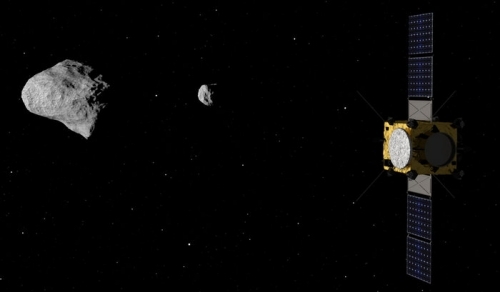
Image: Arrival of AIM at Didymos and Didymoon. Credit: ESA.
Thus the spread between a near-future science fiction story (the acquisition of Grigg-Skjellerup for resources in Seveneves) and present-day technology — we can assume that Stephenson’s comet-catcher has some powerful propulsive assets compared to what we can deploy today. But the novel explains all this on its own terms and I’ll say no more about it. As to AIDA, the words of Patrick Michel give us the gist. Michel is lead on the AIM Investigation team:
“To protect Earth from potentially hazardous impacts, we need to understand asteroids much better – what they are made of, their structure, origins and how they respond to collisions. AIDA will be the first mission to study an asteroid binary system, as well as the first to test whether we can deflect an asteroid through an impact with a spacecraft. The European part of the mission, AIM, will study the structure of Didymoon and the orbit and rotation of the binary system, providing clues to its origin and evolution. Asteroids represent different stages in the rocky road to planetary formation, so offer fascinating snapshots into the Solar System’s history.”
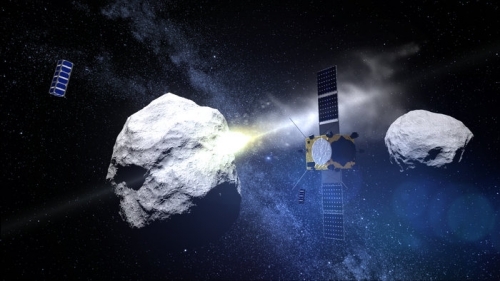
Image: Impact on Didymoon, as observed by AIM and its deployed CubeSats. Credit: ESA.
AIM would launch in October of 2020, with rendezvous at (65803) Didymos in May of 2022. Didymos rotates rapidly, about once every 2.26 hours, and is considered the most accessible asteroid of its size from Earth. Didymoon orbits Didymos every 11.9 hours at an altitude of 1.1 kilometers — the name Didymos (Greek for ‘twin’) was chosen by astronomer Joe Montani, who discovered the objects, when light-curve analysis revealed the binary nature of the asteroid. While Didymos is thought to be a ‘chondrite’ (stony) asteroid, we know nothing about the mass and density of Didymoon, a lack that AIM and DART would be able to correct in short order.
The AIM mission has echoes of Rosetta, for like the latter, it carries a lander. MASCOT-2, built by the German aeronautics and space research center (DLR) will probe the internal structure of Didymoon, emitting low-frequency radar waves that will pass through the object, allowing AIM to chart the deep structure of the asteroid even as it measures Didymoon’s density and maps the surface at visible and infrared wavelengths. DART’s impact with Didymoon is scheduled for October of 2022. I also notice that AIM is scheduled to deploy three CubeSats to assist with impact observations and to test communication links between satellites in deep space.
DART itself is a 300 kg impactor that is designed to carry no scientific payload other than a 20-cm aperture CCD camera to support guidance during the impact approach phase. Launch is currently proposed for July of 2021. The impact at 6.25 kilometers per second is expected to produce a velocity change in the range of 0.4 mm/s, which should change the relative orbit of Didymos and Didymoon but create only a slight change in the binary’s heliocentric orbit.
Related: NASA has funded a concept design study and analysis for a mission called Psyche, which would investigate the interesting asteroid of the same name. Psyche is thought to be the survivor of a collision with another object that stripped off the outer layers of a protoplanet. About 200 kilometers in diameter, it is thought to be the most massive M-type asteroid, with a surface that is 90 percent iron. The Psyche mission, led by Linda Elkins-Tanton (Arizona State) would be an orbiter that would launch in 2020 and arrive in 2026.






Paul Gilster's Blog
- Paul Gilster's profile
- 7 followers


